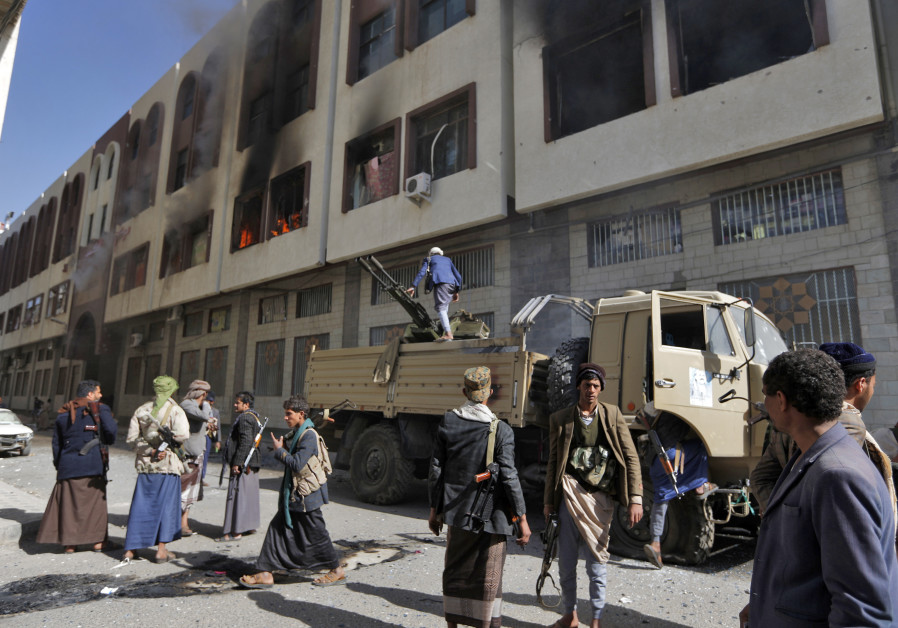The end of Yemen’s Ali Abdullah Saleh was quick and brutal, in contrast to his long regime that left Yemen a failed state

He was the “wily strongman who dominated politics of Yemen since 1978,” writes columnist Hisham Melham. He “reaped what he sowed,” seems to be the general consensus. That reaping took place on a road from Sanaa in Yemen in the direction of Marib. Ali Abdullah Saleh was in a silver four-wheel drive vehicle when it was stopped by Houthi forces who shot out the front left tire and the engine.
Video shows Saleh, dead, wrapped in a red flowery blanket, being placed into the back of a tan truck as men praise God for the former dictator’s death.
The manner of his death reminds many of the killing of Muammar Gaddafi in October 2011 at the beginning of the Arab Spring. Gaddafi’s life ended in a more brutal manner, whereas Saleh seems to have been shot in the head.
The manner of his death reminds many of the killing of Muammar Gaddafi in October 2011 at the beginning of the Arab Spring. Gaddafi’s life ended in a more brutal manner, whereas Saleh seems to have been shot in the head.
In 2004, a rebellion by Houthis began in northern Yemen. Large anti-Saleh demonstrations also erupted in 2007 in the southern city of Aden. In 2011, when Arab Spring protests erupted in Yemen, Saleh was widely expected to be toppled. It took about a year for him to be ushered out of office in early 2012, and Vice President Abd Rabbuh Mansur Hadi became president.
In an assessment of Saleh’s rule and the problems he left behind in Yemen, Jarrod Gilliam wrote a thesis at the Naval postgraduate school in 2011 called “The United States and Yemen.” He noted that “the policies of President Saleh seem to have been chosen based on the importance of regime survival rather than Yemeni prosperity.” Gilliam blamed Saleh’s decades in power for the ossifying regime that allowed al-Qaida in the Arabian Peninsula to rise to power and influence in Yemen.
Saleh neglected large parts of the complex country he ruled, and parts of it slipped away from his rule. He favored certain tribes and not others. Eventually he couldn’t fool all the people all of the time, and he was forced from power. But Saleh couldn’t keep his hand out of the pot. He had almost been assassinated in 2011, but he decided to begin quietly supporting the Houthi rebellion and formally allied with them in 2015.
“His alliance with the Houthis, who he spent most of his political life seeking to annihilate, was always going to end in his beaten, mutilated body being dragged through the streets of Sanaa,” wrote Middle Eastern affairs writer Sam Charles Hamad on Facebook. He says Saleh and the Houthis had different intentions. “Saleh provided the Houthis with essentially one half of Yemen’s security forces and their resources while the Houthis provided Saleh with an army.” He describes Saleh and his Houthi allies as tyrants.
Saudi Arabia, the UAE and allied countries intervened in Yemen in 2015 to prevent the fall of Aden to the Houthis. For two years they have been fighting a brutal war there, which has resulted in starvation and suffering. The Saudis, backing Hadi, hold the south and east of the country, while the Houthis hold Sanaa and the north and west.
Then, in the last days of November, Saleh’s forces tried to take over part of Sanaa and clashed with the Houthis. Observers thought the Houthis would would be weakened as Saleh reached out to the Saudis. Instead it all ended after five days with Saleh’s dead body splayed out in the back of a truck like a trophy. It was “gangsters killing a gangster,” concludes Hamad.
As reported by The Jerusalem Post
